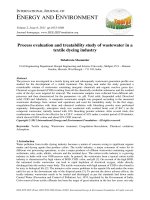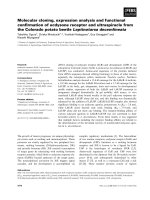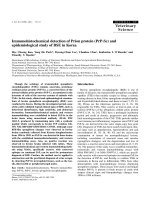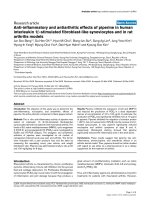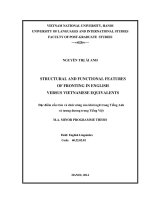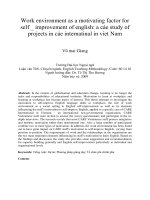EXPRESSION ANALYSIS AND FUNCTIONAL STUDY OF HS3ST3B1 IN HUMAN PROSTATE CANCER
Bạn đang xem bản rút gọn của tài liệu. Xem và tải ngay bản đầy đủ của tài liệu tại đây (9.03 MB, 136 trang )
EXPRESSION ANALYSIS AND FUNCTIONAL
STUDY OF HS3ST3B1 IN HUMAN PROSTATE
CANCER
KWAN LI JUAN
(B.Sc.(Hons.), NUS)
A THESIS SUBMITTED
FOR THE DEGREE OF MASTER OF SCIENCE
DEPARTMENT OF ANATOMY
NATIONAL UNIVERSITY OF SINGAPORE
2013
DECLARATION
I hereby declare that the thesis is my original
work and it has been written by me in its entirety.
I have duly acknowledged all the sources of
information which have been used in the thesis.
This thesis has also not been submitted for any
degree in any university previously.
!
Kwan Li Juan
23 May 2013
Acknowledgements
!
ACKNOWLEDGEMENTS
My MSc candidature would not have been more enriching, if not for
the guidance and support from mentors, family and friends.
I would like to firstly thank my supervisor, Associate Professor
George Yip Wai Cheong, for his guidance and advice in this project.
Through him, I have learnt much in terms of the acquisition of scientific
knowledge and skills. My gratitude goes also to my co-supervisor, Dr Chong
Kian Tai, for always being willing to offer his support and advice.
I would also like to thank Professor Bay Boon Huat and Associate
Professor Tay Sam Wah, Samuel for their timely encouragement and advice.
Professor Bay and Professor Tay have never failed in considering the welfare
of the students and I am very much thankful for their genuine concern and
care.
My deepest appreciation goes to Dr Aye Aye Thike who has spent
much time scoring the immunostained slides with me and for generously
sharing her knowledge and little stories in life. This project would not have
been possible without the excellent technical expertise of Ms Cheok Poh
Yian. Thank you for your help to cut all the prostate tissue sections and for
guiding me in the construction of the tissue microarray.
Thank you Mrs Yong Eng Siang, for making the Cell and
Developmental Biology Laboratory into such a clean and safe workplace. I
would always remember the conversations and nice treats you have given,
making my candidature a much memorable one. Thank you Mrs Ng Geok
Lan and Ms Pan Feng, for your expertise and help to troubleshoot problems
that I had encountered in the Histology Laboratory. I am much grateful too,
!
"!
Acknowledgements
!
for the meaningful conversations we have had. Also to Mr Poon Junwei,
thank you for always being really helpful in the Tissue Culture Laboratory.
Many thanks to all my friends whom I have worked with, for their
helpful opinions pertaining to the project and importantly for their kind and
encouraging words; all the Research Assistants, Ms Sim Wey Cheng, Ms
Serene Ying, Ms Jane Wong, Ms Sharen Lim and Mr Brian Chia, for
helping to keep the lab supply in order; my senior Dr Yvonne Teng, for her
help and advice; my fellow friends, Dr Omid Iravani, Dr Cao Shoufeng, Dr
Grace Leong, Ms Victoria King, Ms Olivia Jane Scully, Ms Guo Tiantian,
Ms Chua Peijou, Mr Lo Soo Ling, Ms Ooi Yin Yin, Ms Xiang Ping and
Ms Sen Yin Ping – it has really been enjoyable learning and working
together! My heartfelt gratitude also to Mdm Ang Lye Geck, Carolyne and
Ms Bay Song Lin for your kind administrative and technical support.
I would also like to thank all staff and students of the Department of
Anatomy, Yong Loo Lin School of Medicine, National University of
Singapore, for all your help, advice and friendship.
My gratitude to National University of Singapore for giving me the
Research Scholarship to enable me to carry out my work.
Most importantly, I thank my family and boyfriend for their unfailing
support through these years. I dedicate this work to them for their love and
magnanimity all this while.
!
""!
Table of contents
!
TABLE OF CONTENTS
Acknowledgements
i
Table of contents
iii
Summary
ix
List of Tables
xi
List of Figures
xiii
List of Abbreviations
xv
Chapter 1
Introduction
1
1.1
Prostate gland and prostate cancer
1
1.1.1
The anatomy of the prostate gland
1
1.1.2
Functions of the prostate gland
2
1.1.3
Epidemiology of prostate cancer
2
1.1.4
Histopathology of the prostate gland
3
Normal histology of the prostate
3
1.1.4.2
Histopathology of prostate adenocarcinoma 4
1.1.5
Gleason grading of prostate cancer
1.1.6
Clinical diagnosis and symptoms of prostate cancer 6
1.1.7
Treatment
8
1.1.8
Risk factors for prostate cancer
10
1.1.9
Prognostic factors for prostate cancer
12
1.1.10
Current challenges
16
1.2
!
1.1.4.1
Glycosaminoglycans and proteoglycans
4
18
1.2.1
Structural composition
18
1.2.2
Chondroitin/dermatan sulphate, keratan sulphate
19
"""!
Table of contents
!
and hyaluronan
1.2.3
Heparan sulphate - biosynthesis and
20
3-O-sulphation
1.2.4
The sulphatases – enzymatic remodeling of
23
heparan sulphate
1.2.5
Heparan sulphate in cellular physiology
24
1.2.6
Heparan sulphate in cancer biology
25
1.2.7
Heparan sulphate in prostate cancer
26
1.3
Summary of Teng (2010) study
31
1.4
Objectives of project
32
Chapter 2
Materials and Methods
34
2.1
In vitro cell culture
34
2.1.1
Cell lines
34
2.1.2
Storage of cells
34
2.1.3
RNA extraction, cDNA synthesis and qPCR of
35
prostate cell lines
2.1.4
2.1.3.1
RNA extraction
35
2.1.3.2
cDNA synthesis
35
2.1.3.3
qPCR of prostate cell lines
36
Quantitative real time polymerase chain reaction
36
(qRT-PCR)
!
2.1.5
Gene expression analysis of qPCR data
37
2.1.6
Gene silencing
37
2.1.7
SULF1 silencing optimisation
38
"#!
Table of contents
!
2.1.8
shRNA plasmid amplification
39
2.1.9
shRNA transfection
40
2.1.10
Antibodies used
41
2.1.11
Western blot – Denaturing and non-denaturing
41
methodologies
2.1.11.1
Extraction of protein
41
2.1.11.2
Preparation of resolving gel
41
2.1.11.3
Preparation of stacking gel
42
2.1.11.4
Separation and eventual visualization of
42
proteins
2.1.11.5
Densitometric analysis of the band intensity 43
2.1.12
Migration assay
43
2.1.13
Invasion assay
44
2.1.14
Proliferation assay
45
2.1.15
Adhesion assay
45
2.1.16
HS3ST3B1 silenced microarray analysis
45
2.1.17
Gene expression data analysis
47
2.1.18
Functional categorization of genes with DAVID
47
2.2
Expression analysis of HS3ST3B1 in prostate
48
adenocarcinoma tissues using immunohistochemistry
2.2.1
Tissue microarray samples and clinicopathological 48
data
!
2.2.2
Tissue microarray construction
48
2.2.3
Immunohistochemical staining
49
2.2.4
Immunohistochemical evaluation
50
#!
Table of contents
!
2.2.5
Statistical analysis
50
Chapter 3
Results
51
3.1
Expression and functional analysis of HS3ST3B1 in
51
prostate cancer
3.1.1
Expression of HS3ST3B1 in prostate cell lines
51
and tissues
3.2
Functional analysis of HS3ST3B1 in prostate cancer
53
3.2.1
HS3ST3B1 is effectively silenced in RWPE-1
53
3.2.2
HS3ST3B1 is effectively silenced at the protein
54
level
3.2.3
HS3ST3B1 silencing increased RWPE-1
57
proliferation
3.2.4
HS3ST3B1 silencing increased RWPE-1 migration 59
3.2.5
HS3ST3B1 silencing increased RWPE-1 invasion
3.2.6
HS3ST3B1 silencing decreased RWPE-1 adhesion 63
61
to collagen type I and fibronectin
3.2.7
HS3ST3B1 shRNA work
3.2.7.1
HS3ST3B1 shRNA plasmid amplification
65
65
and transfection into RWPE-1
3.2.7.2
HS3ST3B1 silencing increased RWPE-1
66
proliferation and adhesion to collagen type I
but decreased RWPE-1 migration and
invasion
3.2.8
!
HS3ST3B1 may act through OPN3 to exert its
68
#"!
Table of contents
!
tumour suppressive effects
3.3
Functional analysis of OPN3 in prostate cancer
74
3.3.1
OPN3 is effectively silenced in RWPE-1
74
3.3.2
OPN3 silencing has no effects on RWPE-1
75
migration and invasion
3.3.3
OPN3 silencing decreased RWPE-1 adhesion to
76
collagen type I and fibronectin
3.4
Immunohistochemical analysis of HS3ST3B1 in
77
prostate cancer
3.4.1
Clinicopathological parameters of prostate
77
cancer patients in study
3.4.2
Expression of HS3ST3B1 in prostate cancer
79
3.4.3
Associations of HS3ST3B1 immune reactive
80
scores in prostate cancer with clinicopathological
parameters
3.4.3.1
Cytoplasm of epithelial cells
81
3.4.3.2
Nucleus of epithelial cells
82
3.4.3.3
Peritumoural stroma
83
3.4.3.4
HS3ST3B1 expression between pT2 and
84
pT3 stages
3.5
Silencing of SULF1 in prostate cancer
3.5.1
Optimisation of SULF1 silencing
86
86
Chapter 4
Discussion
87
4.1
HS3ST3B1 is a tumour suppressor in prostate cancer
87
!
#""!
Table of contents
!
4.2
HS3ST3B1 as a potential prostate cancer biomarker
95
Chapter 5
Conclusions and Future Work
100
5.1
Delineating the functional significance of HS3ST3B1
100
in prostate cancer
5.2
Examining HS3ST3B1 as a potential biomarker in
101
prostate cancer
Chapter 6
!
References
103
#"""!
Summary
!
SUMMARY
Prostate cancer, being one of the most commonly diagnosed cancers in
the United States, contributes to the second leading cause of cancer morbidity.
In Singapore, prostate cancer ranks the third most common cancer amongst
the diagnosed males. Manifestations of the disease can range from an
asymptomatic state to the severe life-threatening form, posing therapeutic and
diagnostic challenges. A deeper understanding of prostate cancer at the
molecular level can help identify potential therapeutics and thus improve the
management of this disease. Moreover, biomarkers are in need to facilitate a
better prediction of clinical outcomes and stratification of patients into the
appropriate treatment plans.
Glycosaminoglycans have been found to participate in various cellular
signaling events and are important regulators of tumour metastasis.
Microarray analysis from a previous study (Teng, 2010) has indicated a
downregulation of HS3ST3B1 in both prostate cancer cell lines and tissues.
The expression level of HS3ST3B1, a gene involved in heparan sulphate
biosynthesis, was verified in prostate cancer cell lines LNCaP and PC-3.
Silencing of this gene was then carried out in normal prostate epithelial cell
line RWPE-1. Downregulating HS3ST3B1 has promoted cellular migration,
invasion and proliferation as well as inhibited cellular adhesion via an
upregulation of OPN3. These results point to the potential role of HS3ST3B1
as a novel therapeutic target. OPN3 was subsequently silenced in RWPE-1 to
determine its functions in normal prostate physiology.
To explore the plausible application of HS3ST3B1 as a biomarker of
prostate cancer progression, immunohistochemistry was performed to
!
"$!
Summary
!
correlate its expression in prostate adenocarcinoma tissues with established
clinicopathological parameters. It was found that high HS3ST3B1 expression
is associated with a lower risk of extraprostatic extension and perineural
invasion as well as cancer involving unilateral lobe and lower pT2 stage and
this may hence predict a better prognosis.
On the whole, my findings established the anti-tumour role of
HS3ST3B1 in prostate cancer cellular behaviour and suggested it to be a good
biomarker of prostate cancer progression. Slight inconsistencies between in
vitro and immunohistochemistry results nonetheless warrant further
investigation to determine if HS3ST3B1 should play a greater role in terms of
therapeutic or diagnostic contexts.
!
$!
List of tables
!
LIST OF TABLES
Chapter 1
Table 1.1
Architectural and cytologic features of prostate
4
adenocarcinoma
Table 1.2
Gleason grades
5
Table 1.3
TNM staging system for carcinoma of the prostate (AJCC) 14
Table 1.4
Potential biomarkers of prostate cancer prognosis
15
(modified from Martin et al., 2012)
Chapter 2
Table 2.1
Sequences of PCR primers synthesized
36
Table 2.2
Programme settings for qPCR
37
Table 2.3
Qiagen HS3ST3B1 and OPN3 siRNA sequences
38
Table 2.4
Ambion SULF1 siRNA sequences
39
Table 2.5
Qiagen HS3ST3B1 and negative control shRNA sequences 39
Table 2.6
Optimal conditions used for immunohistochemistry
49
Adapted from study report, indicating good quality of
70
Chapter 3
Table 3.1
RNA samples sent for processing
Table 3.2
Genespring analysis of filtered upregulated genes
73
upon microarray study
Table 3.3
Clinicopathological details of the 361 cases for
77
immunohistochemical analysis
Table 3.4
!
Summary of the distribution of the number of cases scored 80
$"!
List of tables
!
for different arbitrary cut-offs for IRS
Table 3.5
Histological parameters of prostate cancer correlated with 81
IRS of epithelial cytoplasm HS3ST3B1 positive cells
Table 3.6
Summary of statistically significant correlation between
82
score and clinicopathological parameters
Table 3.7
Histological parameters of prostate cancer correlated with 82
IRS of epithelial nucleus HS3ST3B1 positive cells
Table 3.8
Summary of statistically significant correlation between
83
score and clinicopathological parameters
Table 3.9
Histological parameters of prostate cancer correlated with 83
IRS of HS3ST3B1 positive peritumoural stroma
Table 3.10
Summary of statistically significant correlation between
84
score and clinicopathological parameters
!
$""!
List of figures
!
LIST OF FIGURES
Chapter 1
Figure 1.1
Structure of glycosaminoglycans and proteoglycans
19
Figure 1.2
Biosynthesis of heparan sulphate 3-O-sulphotransferase
23
isoforms
Figure 1.3
Signaling pathways and molecules heparan sulphate may
31
interact with to cause pro-tumourigenic cellular behaviour
Chapter 3
Figure 3.1
Expression level of HS3ST3B1 in prostate cancer cell
52
lines (PC-3 and LNCaP) relative to its normal
counterpart RWPE-1
Figure 3.2
Silencing efficiencies of HS3ST3B1 in RWPE-1 normal
53
prostate epithelial cells
Figure 3.3
HS3ST3B1 is effectively silenced and its expression is
55
significantly reduced at the protein level
Figure 3.4
Immunofluorescence staining of HS3ST3B1
56
Figure 3.5
HS3ST3B1 increased RWPE-1 proliferation
58
Figure 3.6
HS3ST3B1 increased RWPE-1 migration
60
Figure 3.7
HS3ST3B1 increased RWPE-1 invasion
62
Figure 3.8
HS3ST3B1 decreased RWPE-1 adhesion to collagen type I 64
and fibronectin
Figure 3.9
HS3ST3B1 shRNA plasmid transfection in RWPE-1
65
normal prostate epithelial cells
Figure 3.10
!
Effects of HS3ST3B1 silencing on RWPE-1 cellular
67
$"""!
List of figures
!
behaviour
Figure 3.11
Adapted from study report, indicating good quality of
71
RNA samples sent for processing
Figure 3.12
Heatmap indicating the differentially expressed genes
72
upon the downregulation of HS3ST3B1
Figure 3.13
Expression level of OPN3 in RWPE-1 normal prostate
73
epithelial cells
Figure 3.14
Silencing efficiency of OPN3 in RWPE-1 normal prostate 74
epithelial cells
Figure 3.15
OPN3 has no effects on prostate cellular migration
75
and invasion
Figure 3.16
OPN3 decreased RWPE-1 adhesion to collagen type I and 76
fibronectin
Figure 3.17
Immunohistochemical staining of HS3ST3B1
79
Figure 3.18
HS3ST3B1 expression in pT2 and pT3 stages
85
Microarray analysis of HS3ST3B1 silencing in RWPE-1
92
Chapter 4
Figure 4.1
cells
!
$"#!
List of abbreviations
!
LIST OF ABBREVIATIONS
AJCC
American Joint Committee on Cancer
AKT
serine/threonine kinase
AR
androgen receptor
AS
active surveillance
ATCC
American Type Cell Culture
ATP
adenosine triphosphate
BPH
benign prostatic hyperplasia
BSA
bovine serum albumin
cDNA
complementary DNA
cRNA
complementary RNA
CS
chondroitin sulphate
CT
computed tomography
DEPC
diethylpyrocarbonate
DMSO
dimethylsulphoxide
DNA
deoxyribonucleic acid
DRE
digital rectal examination
DS
dermatan sulphate
DSPG
dermatan sulphate proteoglycan
ECM
extracellular matrix
EGF
epidermal growth factor
EGFR
epidermal growth factor receptor
EMT
epithelial-mesenchymal transition
EPE
extraprostatic extension
ERK
extracellular signal regulated kinase
FAK
focal adhesion kinase
FBS
fetal bovine serum
FGF
fibroblast growth factor
FGFR
fibroblast growth factor receptor
GAG
glycosaminoglycan
GAPDH
glyceraldehyde 3-phosphate dehydrogenase
GCOS
GeneChip operating software
GlcA
!-D-glucuronic acid
!
$#!
List of abbreviations
!
GlcNAc
N-acetyl-D-glucosamine
GlcNS
N-sulphate-D-glucosamine
GO
gene ontology
GPI
glycosylphosphatidylinositol
HBGF
heparin binding growth factor
HCL
hydrochloric acid
HGF
hepatocyte growth factor
HGPIN
high-grade PIN
HS
heparan sulphate
HSGAG
heparan sulphate glycosaminoglycan
HSPG
heparan sulphate proteoglycan
IdoA
"-L-iduronic acid
IRS
immunoreactivity score
MAPK
mitogen-activated protein
min
minutes
ml
millilitres
mm
millimetres
MMP-9
matrix metalloproteinase 9
mRNA
messenger ribonucleic acid
MTS
3-(4,5-dimethylthiazol-2-yl)-5-(3
carboxymethoxyphenyl)-2-(4-sulfophenyl)-2Htetrazolium
NADH
nicotinamide adenine dinucleotide
NADPH
nicotinamide adenine dinucleotide phosphateoxidase
NDST
N-deacetylase/N-sulphotransferase
ng
nanograms
nM
nanomolar
PAP
prostate acid phosphatase
PAPS
3'-phosphoadenosine 5'-phosphosulphate
PBS
phosphate buffered saline
PCL
polycaprolactone
PCR
polymerase chain reaction
PDGF
platelet derived growth factor
!
$#"!
List of abbreviations
!
PG
proteoglycan
PI3K
phosphoinositide 3-kinase
PIN
prostatic intraepithelial neoplasia
PlnDIV
perlecan domain IV
PM/MM
perfect match/mismatch
PSA
prostate specific antigen
PUFA
polyunsaturated fatty acids
PVDF
polyvinylidene difluoride
QC
quality control
qPCR
quantitative real-time PCR
RIN
RNA integrity number
RMA
Robust Multi-array Average
ROS
reactive oxygen species
RP
radical prostatectomy
rpm
revolutions per minute
SDS-PAGE
sodium-docedyl-sulphate polyacrylamide gel
electrophoresis
SHH
Sonic Hedgehog
shRNA
short hairpin RNA
siRNA
silencing RNA
SVI
seminal vesicle involvement/invasion
TGF
transforming growth factor
TMA
tissue microarray
TNM
primary tumour (T) – regional lymph nodes (N) –
distant metastasis (M)
TPS
total percentage staining
TRAIL
tumour necrosis factor-related apoptosis-inducing
ligand
TRUS
transrectal ultrasound guided core biopsies
TURP
transurethral resection of the prostate
ug
micrograms
ul
microlitres
um
micrometres
VEGF
vascular endothelial growth factor
!
$#""!
List of abbreviations
!
VEGFR
vascular endothelial growth factor receptor
w/v
weight per volume
WAI
weighted average intensity
Xyl
xylose
!
$#"""!
Introduction
Chapter 1
Introduction
1.1
Prostate Gland and Prostate Cancer
1.1.1
The Anatomy of the Prostate Gland
The prostate lies between the urogenital diaphragm and bladder neck.
With the base of the prostate contiguous with the bladder neck, skeletal
muscle fibres from the urogenital diaphragm extend into its apex up to the
midprostate anteriorly. Though there are no distinct lobes in humans, the lobal
concept of prostate anatomy was sustained in the twentieth century till the
1960s when McNeal established the zonal concept of the prostate gland
(Brooks, 2007; Hammerich, 2009).
The prostate is made up of approximately 70% glandular elements and
30% fibromuscular stroma (Brooks, 2007). The zonal anatomy of the prostate
gland describes four basic anatomic regions: the peripheral, central, transition
and the anterior fibromuscular stroma. The peripheral zone constitutes more
than 70% of the glandular prostate and consists of ducts branching laterally
from the urethra. The cone-shaped central zone constitutes 25% of the
glandular prostate. No major ducts arise in the transition zone, which
combines with tiny periurethral ducts to form the preprostatic region of the
prostate gland. The anterior fibromuscular stroma, a thick nonglandular tissue,
surrounds the prostate’s anterior surface (Hammerich, 2009; McNeal, 1981).
These aforementioned zones of the glandular prostate are usually
associated with specific prostate pathology. Almost all prostate carcinoma
cases occur within the peripheral zone while the transition zone is more
commonly involved in benign prostatic hyperplasia (BPH).
!
"!
Introduction
Notably, the seminal vesicles which are located superiorly to the base
of the prostate are resistant to nearly all prostate diseases. Seminal vesicle
involvement (SVI) is henceforth one of the most important predictors for
prostate cancer progression (Hammerich, 2009).
In the context of prostate cancer progression when lymph node
involvement occurs, it is important to understand that lymphatic drainage in
the glandular prostate passes mainly through the obturator and internal iliac
nodes. A small portion however, may pass through the external iliac nodes
(Brooks, 2007).
1.1.2
Functions of the Prostate Gland
The prostate is an accessory sex gland which serves to support the sperm
function. The acini of the prostatic ducts are composed of secretory, basal and
neuroendocrine cells. The epithelial secretory cells produce both the prostatespecific antigen (PSA) and prostate acid phosphatase (PAP) (Kaisary, 2009).
The prostatic fluid contains citric acid, PAP, prostaglandins, fibrinogen and
PSA. PSA, which is also a diagnostic marker, serves as a serine protease that
liquefies semen after ejaculation (Louis, 2011).
1.1.3
Epidemiology of prostate cancer
Prostate cancer is the second leading cause of cancer morbidity in the
United States. In 2012, it was postulated that approximately 1 in 6 of
American men will be diagnosed with the disease (Brawley, 2012).
Prostate cancer is often termed as a disease of the older men. The
median age at diagnosis was 67 years between 2001 and 2010. With the
prevalence of PSA screening, there is an increased proportion of men being
!
#!
Introduction
diagnosed with localized disease. Notably, less than a third diagnosed with
metastatic disease survive beyond 5 years (Brawley, 2012).
It has also been estimated that more than half of screen-detected
cancers are tumours insignificant to the patient’s health (Etzioni et al., 2002).
Welch and Albertsen have also observed significant unnecessary prostate
cancer treatment (Welch and Albertsen, 2009). Though the assessment of
grade, percent of tumour in the biopsy and staging are important measures of
outcome, they may not predict clinical outcome perfectly (Brawley, 2012).
This thus necessitates better prognostic tools.
1.1.4
Histopathology of the Prostate Gland
1.1.4.1 Normal histology of the prostate
Columnar secretory cells line the ducts and acini of the prostate gland.
These ducts and acini are regularly spaced and are smaller (0.15 to 0.3 mm in
diameter) in the peripheral and transition zones in contrast to the central zone
(0.6 mm in diameter or larger). Within the peripheral and transition zones, the
ducts and acini have simple rounded contours with undulations from the
epithelial border. The central zone however, has ducts and acini that are
polygonal in contour. Distinctive intraluminal ridges form the corrugations
observed in the walls of the central zone (McNeal, 1998).
Importantly, a layer of basal cells separates the secretory cells from the
stroma and basement membrane. These basal cells would normally divide and
mature into secretory cells which produce PSA, PAP, pepsinogen II and tissue
plasminogen activator (McNeal, 1998).
Within the peripheral and transition zones, the secretory cells have
smaller nuclei that are more evenly spaced. Cells are more uniformly
!
$!
Introduction
columnar and the cytoplasm has numerous vacuoles. The central zone in
comparison has crowded columnar secretory cells with more granular
cytoplasm and larger nuclei (McNeal, 1998).
1.1.4.2 Histopathology of Prostate Adenocarcinoma
The diagnosis of prostate adenocarcinoma relies on a combination of
architectural and cytologic features as summarized in the following table
(Table 1.1)(Montironi R., 2007):
Table 1.1 Architectural and cytologic features of prostate adenocarcinoma
Diagnostic features of prostate adenocarcinoma
Architectural features
Malignant acini patterns:
- irregular and haphazard
- wide variation of acini spacing
- variation in size
- irregular contour
Absence of basal cell layer
Cytologic features
Hyperchromatic nuclei
Enlarged nuclei
Enlarged or prominent nucleoli
Mitotic figures
Amphophilic cytoplasm
1.1.5
Gleason grading of prostate cancer
The Gleason grading system for prostate cancer introduced in 1966
(Petersen R.O., 2009), the predominant grading system and strongest
prognostic factor of a patient’s time to progression, is named after Donald F
Gleason. This system constitutes of 5 different grades based on glandular
!
%!
Introduction
architecture. An increasing scale signifies a greater extent of dedifferentiation. Gleason grade 1 or 2 (well differentiated) prostate cancer is
characterized by proliferation of microacinar structures. Enlarged nucleoli are
evident. Gleason grade 5 being the highest grade includes infiltrating
individual cells (Montironi R., 2007).
As prostate cancer is usually heterogeneous, the primary (most
prevalent) and secondary (second most prevalent) grades are summed to
obtain a Gleason score. Score possibilities can thus range from 2 (1 + 1) to 10
(5 + 5) (Hammerich, 2009).
Gleason grading is a significant factor in clinical decision-making as it
predicts the pathologic stage, local recurrences, lymph node status, likelihood
of disease progression and distant metastasis etc. Gleason scores of 7-10 have
been associated with a worse prognosis while a lower progression rate for
scores 5-6. Recently, Gleason score forms part of clinical nomograms to help
predict disease progression. The various Gleason grades are as summarized
below (Table 1.2)(Montironi R., 2007):
Table 1.2 Gleason grades
Gleason grades
Grade 1: single and closely packed acini
Grade 2: single acini that are more loosely arranged and less uniform
Grade 3: single acini, cribriform and papillary patterns can be observed
Grade 4: irregular masses of acini and fused epithelium
Grade 5: anaplastic carcinoma
Though the Gleason system is being internationally recognized, there
are issues of concern. Notably, Gleason grading is subjected to an observer’s
!
&!
